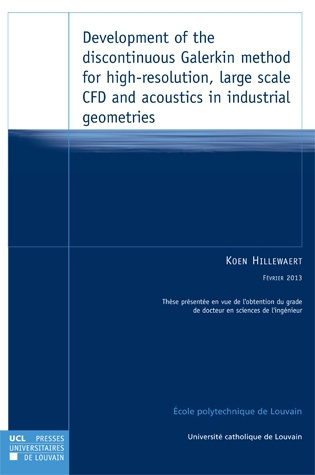Development of the discontinuous Galerkin method for high-resolution, large scale CFD and acoustics in industrial geometries
Première édition
The main objective of this work is the practical development of the discontinuous Galerkin method, arguably the most mature high-order discretisation, for the scale resolving simulations of turbomachinery... Lire la suite
New unstructured high order methods hold the promise of transforming industrial?CFD practices. Their combination of high precision, high geometrical flexibility?and parallel efficiency, make them much better suited for unsteady scale resolving?simulations (DNS, LES, …) of turbulent industrial flows than current industrial codes.?As industrial practices for this type of simulations have not yet been established,?there is an opportunity to increase simulation reliability and resolution capacity by?introducing these novel high-potential methods.?The main objective of this work is the practical development of the discontinuous?Galerkin method, arguably the most mature high-order discretisation, for the scaleresolving?simulations of turbomachinery flows.?First optimal interior penalty parameters, adapted to hybrid and high aspect ratio?meshes, typical for CFD, have been developed. This includes the development of a?sharp trace inverse inequality for all types of elements, as well as the generalisation?of the coercivity analysis.?Based on algebraic primitives performance, a flexible yet extremely efficient blockedmatrix?structure is defined, as well as reorganised assembly routines that compensate?the increase of computational complexity of the high-order quadrature. Different?iterative strategies have implemented and compared, and a generic framework is?presented that provides high-quality transfer operators for h- and p-multigrid.?Some extensions of the DGM towards low Reynolds incompressible flows and?frequential acoustics are furthermore developed and analysed.?The capacities of the developed platform are demonstrated by the direct numerical?simulation of the transitional flow on a low-pressure turbine.
New unstructured high order methods hold the promise of transforming industrial CFD practices. Their combination of high precision, high geometrical flexibility and parallel efficiency, make them much better suited for unsteady scale resolving simulations (DNS, LES, …) of turbulent industrial flows than current industrial codes. As industrial practices for this type of simulations have not yet been established, there is an opportunity to increase simulation reliability and resolution capacity by introducing these novel high-potential methods. The main objective of this work is the practical development of the discontinuous Galerkin method, arguably the most mature high-order discretisation, for the scaleresolving simulations of turbomachinery flows. First optimal interior penalty parameters, adapted to hybrid and high aspect ratio meshes, typical for CFD, have been developed. This includes the development of a sharp trace inverse inequality for all types of elements, as well as the generalisation of the coercivity analysis. Based on algebraic primitives performance, a flexible yet extremely efficient blockedmatrix structure is defined, as well as reorganised assembly routines that compensate the increase of computational complexity of the high-order quadrature. Different iterative strategies have implemented and compared, and a generic framework is presented that provides high-quality transfer operators for h- and p-multigrid. Some extensions of the DGM towards low Reynolds incompressible flows and frequential acoustics are furthermore developed and analysed. The capacities of the developed platform are demonstrated by the direct numerical simulation of the transitional flow on a low-pressure turbine.
Spécifications
- Éditeur
- Presses universitaires de Louvain
- Partie du titre
-
Numéro 422
- Auteur
- Koen Hillewaert,
- Collection
- Thèses de l'École polytechnique de Louvain
- Langue
- anglais
- BISAC Subject Heading
- TEC000000 TECHNOLOGY & ENGINEERING
- Code publique Onix
- 06 Professionnel et académique
- CLIL (Version 2013-2019 )
- 3069 TECHNIQUES ET SCIENCES APPLIQUEES
- Date de première publication du titre
- 10 février 2013
- Subject Scheme Identifier Code
- Classification thématique Thema: Technologie, ingénierie et agriculture, procédés industriels
Livre broché
- Date de publication
- 10 février 2013
- ISBN-13
- 978-2-87558-119-8
- Ampleur
- Nombre de pages de contenu principal : 172
- Dépôt Légal
- D/2013/9964/6 Louvain-la-Neuve, Belgique
- Code interne
- 87757
- Format
- 16 x 24 x 1 cm
- Poids
- 288 grammes
- Prix
- 30,00 €
- ONIX XML
- Version 2.1, Version 3
Google Livres Aperçu
Publier un commentaire sur cet ouvrage
Si vous avez une question, utilisez plutôt notre formulaire de contact
Sommaire
1 Introduction 1
1.1 Motivation . 1
1.2 Overview 8
2 The discontinuous Galerkin method 11
2.1 Model equations11
2.2 Elements and functional spaces . 12
2.3 Variational formulation 14
2.4 Shape functions23
3 Extending the DG variational formulation 27
3.1 Stability of the interior penalty method on hybrid meshes27
3.2 Non-conformal formulation . 35
3.3 Frequential formulation of the homentropic LEE . 44
4 Iterative methods 57
4.1 Newton methods . 59
4.2 Multigrid methods 63
4.3 Concluding remarks . 71
5 Efficient data structures 75
5.1 Algebraic primitives on the computer . 76
5.2 Data Structures84
5.3 Efficient assembly . 89
5.4 Conclusions 102
6 noFUDGe: a first industrial application 105
6.1 Description of the flow 106
6.2 Computational setup . 106
6.3 Comparison of computed flow fields108
6.4 Validation . 114
6.5 Comparison of computational cost. 116
6.6 Scaling tests 116
6.7 Conclusions 118
i
ii CONTENTS
7 Current status and prospects 119
7.1 Conclusions 119
7.2 Current status of the Argo group 120
7.3 Prospects 121
A Elements of functional analysis A.3
A.1 Hilbert spaces. A.3
A.2 Solvability of variational problems. A.4
A.3 The Lax-Milgram theoremA.5
A.4 The most simple exampleA.5
B Function spaces, reference elements and quadrature A.7
B.1 Construction of Lagrange interpolants . A.7
B.2 Interpolation on the boundary A.8
B.3 Specific elements . A.9
B.4 Quadrature rules . A.12
C Sharp values for the trace inverse inequality A.15
C.1 Simplices A.16
C.2 Outline ofWarburton's method . A.16
C.3 Tensor product elements. A.17
C.4 Wedges . A.19
C.5 Lagrange interpolation on pyramidsA.21
C.6 The Pascal space on the pyramid A.25
D Nonlinear instability of quadrature-free methods A.27
D.1 Original formulation . A.27
D.2 Extension to non-linear equations of state . A.30
D.3 Spurious modesA.30
Bibliography i

